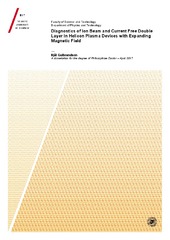Diagnostics of Ion Beam and Current Free Double Layer in Helicon Plasma Devices with Expanding Magnetic Field
Permanent link
https://hdl.handle.net/10037/11633View/
Thesis (PDF)
Paper 1: Miloch, W. J., Gulbrandsen, N., Mishra, L. N., Fredriksen, Å.: «The role of acceptance angle in measurements with ion energy analyzers: Study by numerical simulations”. Also available in Applied Physics Letters 2010, 97:261501.
(PDF)
(PDF)
Paper 2: Miloch, W. J., Gulbrandsen, N., Mishra, L. N., Fredriksen, Å.: «Ion velocity distributions in the sheath and presheath of a biased object in plasma”. Also available in Physics of Plasmas 2011, 18:083502. (PDF)
Paper 3: Gulbrandsen, N., Miloch, W. J., Fredriksen, Å.: «Interpretation of Ion Velocity Distributions Measured with a Grounded Retarding Field Energy Analyzer (RFEA) in an Inductively Coupled Helicon Plasma”. Also available in Contributions to Plasma Physics 2013, 53(27). (PDF)
Paper 4: Gulbrandsen, N., Fredriksen, Å., Carr, J., Scime, E.: «A comparison of ion beam measurements by retarding field energy analyzer and laser induced fluorescence in helicon plasma devices”. Also available in Physics of Plasmas 2015, 22:033505. (PDF)
Paper 5 : Gulbrandsen, N., Fredriksen, Å.: «RFEA Measurements of High-Energy Electrons in a Helicon Plasma Device with Expanding Magnetic Field». Also available in Frontiers in Physics 2017, 5(2). (PDF)
Date
2017-09-18Type
Doctoral thesisDoktorgradsavhandling
Author
Gulbrandsen, NjålAbstract
The main focus of this thesis is the diagnostics of ion beams in helicon plasma devices with expanding magnetic field, and running in an inductive mode. These ion beams are closely connected to the concept of current-free double layers (CFDL).
We started by investigating how to best interpret the measurements from a Retarding Field Energy Analyzer (RFEA) through 3-dimensional particle-in-cell simulation. A RFEA will be surrounded by a sheath. The ion distribution function (IDF) measured at the probe will be distorted compared to the IDF in the plasma unaffected by the sheath.
We discovered that the width of the distribution measured by RFEA was larger than expected from 1-dimensional theory. In addition, we found that the low energy part of the distribution was an effect of the probe acceptance angle. Wide acceptance angles give stronger signals at the expense of developing a low energy tail in the IDF. The low energy tails are due to ions entering the aperture at large inclination angles, so that a significant part of their momentum is in the tangential component of the velocity not seen by the probe. Due to the distorted picture of the IDF in the plasma, we found that for the relevant parameter range the RFEA can not provide a reliable ion temperature estimate.
We also found that the maximum (peak) of the IDF is at voltages slightly lower than the plasma potential. This could be associated with the potential drop in the presheath. Thus, the peak of the IDF can be associated with the plasma potential in the close vicinity to the analyzer.
Then we went on to compare RFEA-measurements with Laser Induced Fluorescence (LIF) measurements of ion velocity distribution. While the RFEA-diagnostics is intrusive and will disturb the plasma somewhat, the LIF-diagnostics is none-intrusive. The RFEA measures the ion distribution after it has been accelerated through the sheath surrounding the probe while LIF measures the ion velocity distribution in the plasma itself, without disturbing it. A new method to compare the two techniques is presented. By converting the LIF velocity distribution to an equivalent of a RFEA measurement using a simplified sheath model, we found good agreement between beam energies of the two methods. We also observed that the RFEA is capable of measuring ion beams with densities too low for the LIF to resolve, while the LIF-technique better resolves the back-ground ion distribution. We compare LIF and RFEA measurements in two different helicon plasma devices, the Njord device at the University of Tromsø and the HELIX-LEIA device at West Virginia University.
At last, we apply a RFEA to measure high-energy electrons. By inverting the grid volt-ages, a RFEA can be used to measure electrons. Only electrons with energies high enough to overcome the sheath will reach the probe. Therefore, we would only measure the high-energy part of the electron distribution.
Description
Publisher
UiT Norges arktiske universitetUiT The Arctic University of Norway
Metadata
Show full item recordCollections
Copyright 2017 The Author(s)
The following license file are associated with this item:


 English
English norsk
norsk
